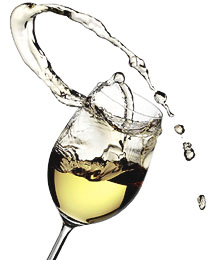 I’m in the process of making my first batch of wine. I’m making apple wine. When I started, I took a hydrometer reading and it was in between 1.080-1.100. I let it ferment in the bucket for about a week and a half. When I racked it into the carboy I took another hydrometer reading and it was about the same.(this was on the 7th of January.) I just took another hydrometer reading today( Jan 21) and the hydrometer wouldn’t even float inside the wine thief. Did I screw something up or is the wine ready to be filtered and bottled. I also tasted the wine. It had a really good flavor but it also had a little tartness to it. Please tell me that it’s ok, I really don’t want to have to dump it out!
I’m in the process of making my first batch of wine. I’m making apple wine. When I started, I took a hydrometer reading and it was in between 1.080-1.100. I let it ferment in the bucket for about a week and a half. When I racked it into the carboy I took another hydrometer reading and it was about the same.(this was on the 7th of January.) I just took another hydrometer reading today( Jan 21) and the hydrometer wouldn’t even float inside the wine thief. Did I screw something up or is the wine ready to be filtered and bottled. I also tasted the wine. It had a really good flavor but it also had a little tartness to it. Please tell me that it’s ok, I really don’t want to have to dump it out!
Name: Ben Marquard
State: Wisconsin
Hello Ben,
Do not dump it out. I repeat, do not dump it out. Your first hydrometer reading of 1.080 – 1.100 indicates that it was in a reasonable range for starting a fermentation. This reading indicates that your final alcohol level should end up around 10.5% to 12%. Your second reading I can not explain. After a week and a half you should have had a reading around .996 – 1.020 on your gravity hydrometer. You said it did not change.
Now you are saying that you can not get the gravity hydrometer to float. That is good news! This is an indication that your fermentation is almost done, if not done already. The reason the wine hydrometer will not float is because you do not have it in something deep enough to test for the final reading.
You should be expecting a Specific Gravity reading at this point of around 0.994 to 0.998. This is at the very tip-top of the hydrometer’s scale, so you need something deep enough to get it to float and get the reading. Find something taller to test the apple wine in, or you can put the gravity hydrometer directly into the batch of apple wine to get the reading.
What I suspect you will find is that the fermentation has completed and all that needs to be done now is to give the wine time to clear up and then eventually bottle. You have the option of back-sweetening the wine with sugar before bottling, but you must also add Potassium Sorbate or the wine will start fermenting again in the bottle.
You should also be using sulfites such as sodium metabisulfite or Campden tablets in your wine. At minimum, you should be adding either of these right before bottling. If you plan on bulk-storing the wine before bottling then you should add a dose sooner and then again at bottling time.
One thing I might suggest for future batches is to get a hydrometer jar. This is basically a tall tube that allows you to take accurate readings. You might also want to take a look at the following article on our website: “How To Make Homemade Wine“.
Happy Wine Making,
Ed Kraus
———————————————————————————————————
Ed Kraus is a 3rd generation home brewer/winemaker and has been an owner of E. C. Kraus since 1999. He has been helping individuals make better wine and beer for over 25 years.
Category Archives: Q&A
Why Did My Homemade Wine Start Re-Fermenting?
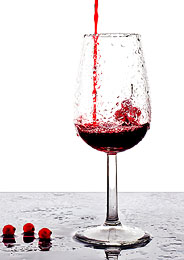 Sort of new to the wine making process, but have been very successful or lucky so far. I’ve made 4 flavors of wine in the past and have tasted well above my expect ions. But a year ago I started a cranberry wine and it has been doing great for a year now but recently it began to start to referment. Why now? It’s temp and location hasn’t changed. I’ve racked it every 3 months as it called for, very little sediment is collected on the bottom of the carboy. Why would this occur now and how or do I want to stop the process? It is stored at temperatures between 59 and 61 degrees. I have never added a sugar solution to increase the taste. I have only racked the wine every 3 months.
Sort of new to the wine making process, but have been very successful or lucky so far. I’ve made 4 flavors of wine in the past and have tasted well above my expect ions. But a year ago I started a cranberry wine and it has been doing great for a year now but recently it began to start to referment. Why now? It’s temp and location hasn’t changed. I’ve racked it every 3 months as it called for, very little sediment is collected on the bottom of the carboy. Why would this occur now and how or do I want to stop the process? It is stored at temperatures between 59 and 61 degrees. I have never added a sugar solution to increase the taste. I have only racked the wine every 3 months.
I’m not sure what other information you need in order to better help me. Any input or idea’s would be greatly appreciated. Waited a long time for this one. Thank-you Renee
Name: Renee
State: MN
The fact that you are still getting any sediment out of a wine after a years time is somewhat disturbing. It is possible to get some proteins such as tannin to drop out over time, but that normally happens at warmer temperatures, not the temperatures you have indicated. Because of this, one of the first things that comes to mind is: did the wine ever complete its fermentation originally?
If a fermentation is healthy and timely it will complete in one to two weeks. The rest of the time involved is just getting the wine to clear. If you haven’t done so already, it would be useful to take a gravity hydrometer reading to make sure that all the ordinal sugars were fermented and that you don’t have a fermentation that’s spread out over a years time. The hydrometer reading should be .996 or less on the Specific Gravity scale. If you get a Specific Gravity reading that is higher than this, then this opens the the door to the possibility that what you are seeing is, in fact, a refermentation.
As to your questions, “why now?” Even though you have your wine stored in cool temperatures, the rackings could be causing the problem, themselves. When a racking is performed more oxygen is introduced to the wine. This can do one of two things: 1) it can invigorate the wine yeast to ferment some more, 2) it can invigorate bacteria or mold to grow.
If you have been adding sulfites such as Campden tablets or Sodium Metabisulfite to the wine after each racking #2 is not very likely to be the problems, but if you have not been adding sulfites along the wine the #1 or #2 is very possible.
I hope this information helped you out. My goal is to cover the most likely scenarios. At this point what needs to happen is a gravity hydrometer reading. If the reading indicates the fermentation is complete, then add sulfites to the wine to stop whatever activity is occurring.
Happy Wine Making,
Ed Kraus
———————————————————————————————————
Ed Kraus is a 3rd generation home brewer/winemaker and has been an owner of E. C. Kraus since 1999. He has been helping individuals make better wine and beer for over 25 years.
Why Does My Wine Taste Like Vinegar?
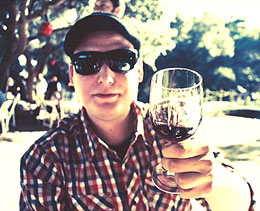 I have made several attempts at making wine. I have used grape juice (Welch’s), rhubarb, blackberry, and have even purchased a kit to make some Merlot. My problem is that they all taste nearly the same with a hint of vinegar. I have been careful to wash and sanitize everything. I am going to try again soon but don’t know what to do different. I even purchased new siphon hose for the Merlot kit and it still had the same off taste.
I have made several attempts at making wine. I have used grape juice (Welch’s), rhubarb, blackberry, and have even purchased a kit to make some Merlot. My problem is that they all taste nearly the same with a hint of vinegar. I have been careful to wash and sanitize everything. I am going to try again soon but don’t know what to do different. I even purchased new siphon hose for the Merlot kit and it still had the same off taste.
Name: Keith H.
State: KS
Hello Keith,
Sorry to hear about the trouble you are having. I can feel the frustration in your writing. There are four ways in which a wine can be taken over by vinegar to some degree, regardless of how much you clean your equipment:
1. Fermentation Is Too Warm: A fermentation should never get over 75° F. When it does it is making life more comfortable to unwanted things like mold, bacteria — vinegar growth is primarily caused by a bacteria know as acetobacter. They like the warmer temperatures and can grow quite comfortably in it. If your fermentation has been getting in the 80’s then this could be the issue.
2. Fermentation Is Too Slow: If you do not have a vigorous fermentation this can leave room for a unwanted microbes to flourish. As a bit of analogy, think of your fermentation as your lawn. The grass is the wine yeast and the weeds are the mold, bacteria, germs… everything you don’t want. One of the best ways to keep the weeds down is to make sure that you have a good stand of grass. The grass takes up everything leaving less for the weeds. It’s no different with a fermentation. By having a good stand of wine yeast you keep these threatening elements at bay.
3. To Much Air Exposure After Fermentation: If you have an active fermentation, exposure to air is not an issue. It’s after the fermentation is over that care needs to be taken. The number one source of air is having too much head-space in the fermenter. Once the fermentation is over you need to eliminate the head-space to keep the wine fresh. Move the wine to another container(s) that it can completely fill. Air allows the vinegar bacteria, acetobacter, to grow.
4. Fermenting With Yeast Under Stress: What I mean by stress is that the wine yeast is not happy. It is not in an environment that is agreeable. This is related to both #1 and #2 above. If the fermentation is too warm the yeast is not happy, and if the fermentation is slow, this is a symptom of an unhappy yeast. The reason behind this is because yeast produces vinegar just like a bacteria does. Just not very much. A healthy fermentation will produce somewhere around .04% of vinegar, but routinely goes as high as .08%. This is a very subtle amount. But if the yeast gets put under stress it can go as high as .15%. An amount that is noticeable.
What can put a yeast under stress? We already covered one of them: the fermentation being too warm. But beyond this, the wine yeast can be over-worked. This can happen when too little yeast is trying to do too much fermentation, or if you use the wrong type of yeast…say a beer yeast or baking yeast instead of using an actual wine yeast. An over-worked yeast can also result from lack of nutrients. This is common issue when water is called for in the wine recipe instead of straight juice. In these situations it is imperative that you also add either a yeast nutrient or yeast energizer to the wine must. There are others. Just realize that keeping the yeast happy will help to keep the vinegar down. You might want to take a look at the “Top Ten Reasons For Fermentation Failure“. This will go over the others in more detail.
Having said all this, please realize that keeping everything sanitary is the #1 reason for getting vinegar in a wine. What I have written above is with this assumption. Keeping things sanitary is first!
In addition, another blog post that may be helpful is “Will My Wine Turn To Vinegar By Racking It?” It approaches this issue from a slightly broader perspective.
Best Wishes,
Ed Kraus
———————————————————————————————————
Ed Kraus is a 3rd generation home brewer/winemaker and has been an owner of E. C. Kraus since 1999. He has been helping individuals make better wine and beer for over 25 years.
Question About Preparing Wine Making Fruit
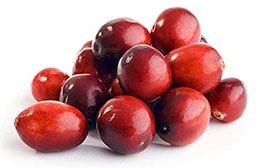 Help!! I am going to try to make cranberry wine from fresh frozen cranberries. What is the best way to get the juice from them. I have tried the blender to break them up… didn’t work…and it would take forever to cut each one— Now I am cooking them as that seems to pop the berry for me. what is the secret???
Help!! I am going to try to make cranberry wine from fresh frozen cranberries. What is the best way to get the juice from them. I have tried the blender to break them up… didn’t work…and it would take forever to cut each one— Now I am cooking them as that seems to pop the berry for me. what is the secret???
Ellen
Name: Ellen Nelsen
State: Wisconsin
Hello Ellen,
When making wine from almost all fresh fruit, you do not what to extract the juice, but rather you want to put the fruit in the fermentation, itself. The fermentation activity is what extracts the juice and flavor from the fruit. It does it for you.
This doesn’t mean that there’s nothing for you to do. You still have to break the fruit up, but not nearly to the degree you where envisioning for extracting the juice. All that is required is that you coarsely chop the cranberries. It is important that you do not mince them or put them in a blender. This would be over-kill and would most likely result in a bitter wine. Only a coarse chopping is required.
During the fermentation, enzymes from the wine yeast will break down the cranberries fiber and release of the fruit’s good flavor. On around the 5th day of fermentation you will want to move the wine must to a new fermenter, leaving the sediment and cranberries behind. This is a process know as racking.
Optionally at this point, you can squeeze the cranberries by hand, or if you have a lager volume to deal with, by wine press. One of the wine making products we offer is a fermentation bag. It makes this process very easy to handle. It is basically a nylon bag with a coarse mesh and drawstring that keeps the fruit collected while in the fermenter. You just put the whole bag of fruit into the fermenter. After a few days of fermentation you simply pull the fermentation bag out and wring the juice out by hand.
Ellen, I hope this information helps you out.
Happy wine making,
Ed Kraus
———————————————————————————————————
Ed Kraus is a 3rd generation home brewer/winemaker and has been an owner of E. C. Kraus since 1999. He has been helping individuals make better wine and beer for over 25 years.
I Need A Wine Recipe For My Ground Cherry Jam!
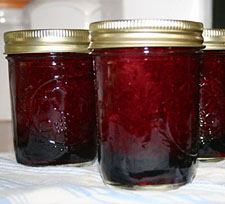 I have really become enamored with the flavor of ground cherries and have made jam and marmalade with them this year, but really want to make some wine with the few quarts left in the freezer from summer, but none of my wine making books mention using them…any ideas? Was planning on mixing white grape concentrate with them, but don’t know what amounts to use. Thanks for your help-
I have really become enamored with the flavor of ground cherries and have made jam and marmalade with them this year, but really want to make some wine with the few quarts left in the freezer from summer, but none of my wine making books mention using them…any ideas? Was planning on mixing white grape concentrate with them, but don’t know what amounts to use. Thanks for your help-
Name: Debra Macone
State: Tennessee
Hello Debra,
While it is possible to make wine using ground cherries, there are two issues that need to be brought up:
The first is the ground cherries themselves. One of the common mistakes I see among beginning wine makers is over processing the fruit they use. If one was to normally make wine from fresh cherries, they would only want to burst or crush the cherries. Smash them up; that’s it. Shredding the cherries or making a puree out of them is way too much from making wine. Doing so allows too much tannin from the skins to release into the wine, giving it a bitter astringency.
Your cherries have been ground. This may be great for jam and marmalade, but a real concern when making wine. One thing you mentioned was that you would like to use a white grape concentrate in the wine recipe. This may be the one thing that will allow you to get away with using the ground cherries. By cutting them with something with less tannin, such as the white grape concentrate, you can bring the wine recipe back into balance. I would recommend somewhere around equal parts of each.
This brings ups to the second issue which is the wine recipe, itself. I do not know of a wine recipe that is going to directly help you out. In all honesty you can create your own recipe with just a little bit of reading and understanding. Some great information is in the article, “Creating Your Own Wine Making Recipe” that is on our website. It explains that by learning how to use a wine hydrometer to adjust the sugar of the wine must, and how to take acid test readings to adjust the acidity of the wine must, you can develop your own recipe out of almost any source of produce you run across. As far as how much of your jam or marmalade to use, I would guess between 1 and 1.5 pints of jam with an equal part of white grape concentrate for each gallon of wine.
Thanks for the great question.
Ed Kraus
———————————————————————————————————
Ed Kraus is a 3rd generation home brewer/winemaker and has been an owner of E. C. Kraus since 1999. He has been helping individuals make better wine and beer for over 25 years.
Part Of My Batch Of Wine Is Bland!
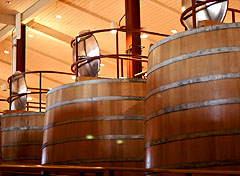 I made 25 gallons of yellow plum wine this summer (began in August 2012). One batch in one of the 5-gallon carboys looks and has the consistency of water (not very interesting) and appears to have finished all of its fermentation. I’ve calculated its alcohol content to be around 12%, but its bland, dry flavor suggests that I add sugar before bottling, but this doesn’t seem to help much when I add sugar syrup in a glass to taste. Can I add brandy to fortify it? How much or what would you add to a very dry, uninteresting wine like this? It hasn’t turned bad, it’s just poor quality.
I made 25 gallons of yellow plum wine this summer (began in August 2012). One batch in one of the 5-gallon carboys looks and has the consistency of water (not very interesting) and appears to have finished all of its fermentation. I’ve calculated its alcohol content to be around 12%, but its bland, dry flavor suggests that I add sugar before bottling, but this doesn’t seem to help much when I add sugar syrup in a glass to taste. Can I add brandy to fortify it? How much or what would you add to a very dry, uninteresting wine like this? It hasn’t turned bad, it’s just poor quality.
Name: Kathy
State: WA
Hello Kathy,
Thanks for the interesting question. I think that we can both agree that since these carboys of wine are all yellow plum, started at the same time, that some of the batch was not treat the same as the rest. Therefore, you have this one carboy that sticks out like a sore thumb.
From the symptoms you gave it sound like the particular carboy in question is lacking in body and flavor. This is caused by the fermentation not have enough contact with the pulp. This pulp is where the flavor and character of the wine comes from. Since this 5 gallons of wine is short on pulp, my guess is that you may have another carboy or two that is long on pulp.
With that said, there are two ways you can go about resolving this issue. Adding plum brandy is not one of them:
The first method is to cross-rack the 5 carboys of plum wine that you have. This is how a commercial winery would have handled it from the beginning. With each racking they would have gone from two carboys simultaneously into one carboy, and then another. By the time you get to the last racking, before bottling, the wine would be evenly blended. Since I assume that you have already done most of the rackings, this may not be a practical option for you at this time. It’s up to you as to whether or not you want to go through this process a couple of times. I you do decide to, I would urge you to make sure that your sulfite levels in the wine are correct after complete the blending.
The second method you could use is to treat the 5 gallons of wine in question and leave the others out of it. Adding brandy would not resolve the issue. While the additional flavor the brandy would add — particularly a plum brandy — would be great, the additional alcohol would make the wine too high in alcohol, or too hot. This additional alcohol would numb the tongue while drinking, giving the wine an even more watery impression.
Adding flavor is about your only option if you choose to take this route. I would suggest using one of our liqueur flavorings. These have been used successfully by many winemakers to enhance their wines. They come in many, many flavors and are very, very strong. One bottle per 5 gallons is the most I would recommend using.
Best Wishes,
Ed Kraus
———————————————————————————————————
Ed Kraus is a 3rd generation home brewer/winemaker and has been an owner of E. C. Kraus since 1999. He has been helping individuals make better wine and beer for over 25 years.
Where Can I Find Pabsts Blue Ribbon Malt?
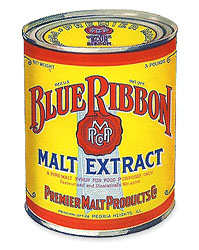 My dad used to make home brew in the 50s and 60s with Pabst Blue Ribbon malt. A website directed me to you for the malt. I don’t find any of your malts with a reference to Pabst Blue Ribbon. Can you help me please! Thanks in advance.
My dad used to make home brew in the 50s and 60s with Pabst Blue Ribbon malt. A website directed me to you for the malt. I don’t find any of your malts with a reference to Pabst Blue Ribbon. Can you help me please! Thanks in advance.
Name: C. Rusmisel
Hello Mr. Rusmisel,
I’m sorry to say that Pabst Blue Ribbon malt extract is no longer with us. We carried it up until about 2 years ago when its production was completely halted.
Back in the 50’s and 60’s it was the only malt you could find on the grocery store shelf. It was mostly sold for “baking” (wink, wink) and was a plain, light syrup. In 1985 Pabst Brewing was taken over by a new owner and the Pabst can malt extract production was taken over by another company all together and renamed “Premier Malt” The labeling looked very similar except for the name itself, Premier.
Premier Malt added different varieties of malt besides just “light”. In addition, you could get it in dark, extra pale and pale light… with or without hops. We carried them all and home brewers loved them. Unfortunately, as home brewing became more popular, so came the competition, and eventually Blue Ribbon Malt was squeezed out.
Now you can get malt extract in many different brands and many different flavors. There’s no shortage of choices. The two main brands we now have are Briess and Munton’s malt extract. Between both brands there are 15 flavors to choose from. We also have malt extract kits. These are blended malts that produce specific styles of beer, everything from American Light to Stout. We carry these blended kits in 5 different that offer a combined 26 different styles of home brew.
My point here is that while Pabst Blue Ribbon malt is no longer produced, that’s no reason not to make beer. There are more choice of malt available now than ever before providing the home brewer with a great opportunity to brew a wide variety of beers.
Happy Brewing,
Ed Kraus
———————————————————————————————————
Ed Kraus is a 3rd generation home brewer/winemaker and has been an owner of E. C. Kraus since 1999. He has been helping individuals make better wine and beer for over 25 years.
How Do I Get The Wine From The Sediment?
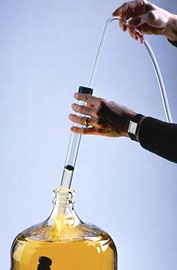 I used too much Speedy Bentonite to clear my last batch of wine. The bentonite worked, but there is a bunch of sediment. I racked off the wine that was clear. It tasted fine. There is about a gallon and a half of sediment. Will the bentonite continue to settle and is it worth the time and trouble for a few extra bottles
I used too much Speedy Bentonite to clear my last batch of wine. The bentonite worked, but there is a bunch of sediment. I racked off the wine that was clear. It tasted fine. There is about a gallon and a half of sediment. Will the bentonite continue to settle and is it worth the time and trouble for a few extra bottles
Name: Hans Wikle
State: WV
Hello Hans,
The general rule-of-thumb is to always get as much liquid as you can when you rack (siphon) your wine, even if it comes along with some sediment. It is only during your last racking, before bottling, that you need to be concerned with leaving all the sediment behind. By the time you get to that part of the process there will be little more than a dusting of sediment to avoid.
If you use this approach what you will discover is that your homemade wine will be just as clear when it comes time to bottle, and you will have much less loss of wine. This is true whether or not you add Bentonite to the wine.
You said you have already racked the wine, so I am assuming that you have a fermenter with this sediment and liquid in the bottom. Go ahead and try to get the liquid out and add it to your new fermenter that you just racked into. In the future, when your rack your wine, don’t stop when you get to the sediment, just keep going until you have all the liquid.
One item you may want to consider purchasing is a racking cane. It is basically a piece of clear rigid tubing that you slip onto the end of your siphon hose. Not only will it help you to direct where your siphon is pulling from (like a wand), it also comes with a diversion cap on the very tip of the wand. This keeps your from accidentally digging the racking cane into the packed sediment and drawing it. These racking canes come on all different lengths and have a curve at the top-end so that you do not have to worry about your siphon hose crimping as it comes out of the fermenter.
Best Wishes,
Ed Kraus
———————————————————————————————————
Ed Kraus is a 3rd generation home brewer/winemaker and has been an owner of E. C. Kraus since 1999. He has been helping individuals make better wine and beer for over 25 years.
Can I Sanitize My Wine Bottles With Hydrogen Peroxide?
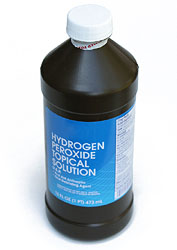 Ed,
Ed,
I rinsed my bottles with a mild solution of hot water and hydrogen peroxide. could this hurt the wine when it is bottled??.
Name: Butch Bellas
State: PA
Hello Butch,
Using hydrogen peroxide in hot water as a rinse for your wine bottles will not hurt the wine in any way, but it should be pointed out that this is not an effective sanitizer. If your purpose is to sanitize the wine bottles, then you need to do something completely different.
If using hydrogen peroxide as a sanitizer it needs to be used as a 3% solution. This is the strength you will find it on the store shelf. When you dilute it with water you are making it too weak to do any good. It needs to be used straight out of the bottle to sanitize. As you can start to imagine this can be cost prohibitive.
A better and cheaper way to sanitize wine bottles is to use one of the many sanitizers we offer. The three most popular are PBW, StarSan, and Easy Clean. If used as direct there is no question that your wine bottles will get completely sanitized.
Any of these sanitizers can also be used to sanitize your equipment or or anything else your wine or beer comes in contact with. This will help to insure that you never have to experience a spoiled batch.
Best Wishes,
Ed Kraus
———————————————————————————————————
Ed Kraus is a 3rd generation home brewer/winemaker and has been an owner of E. C. Kraus since 1999. He has been helping individuals make better wine and beer for over 25 years.
My Persimmon Wine Won't Clear!
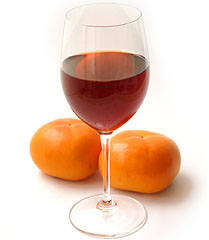 I have been making wine for over a year and lately have had no trouble clearing the wines. I started a 6 gallon batch of persimmon wine 1st Nov. According to our wine recipe it should be ready to bottle in the next week but it is still not clear. I have used several clearing agents. Will it clear if I just leave it for an extended period of time? I am going to rack it again. There is a lot of sediment in the bottom of the carboy. I have heard of people making persimmon wine so since I got the persimmons free I wanted to try it. Have you heard from anyone who has made persimmon wine.
I have been making wine for over a year and lately have had no trouble clearing the wines. I started a 6 gallon batch of persimmon wine 1st Nov. According to our wine recipe it should be ready to bottle in the next week but it is still not clear. I have used several clearing agents. Will it clear if I just leave it for an extended period of time? I am going to rack it again. There is a lot of sediment in the bottom of the carboy. I have heard of people making persimmon wine so since I got the persimmons free I wanted to try it. Have you heard from anyone who has made persimmon wine.
Name: Sandra Fey
State: Ky
Hello Sandra,
Thank you for the great question, and yes, I have heard of people making persimmon wine. I have never made it myself, but have partaken in it more than once.
There are a couple of things that could be going on with your wine. The first is that it may still be fermenting, only very slowly. It is not uncommon for a fermentation to drag on for extended periods of time when cooler weather comes upon us. Wine yeast are very sensitive to temperature. If your wine is in the 60’s, instead of the 70’s this could be your issue.
Fortunately, it is very easy to determine if temperature is the culprit. Simply take a hydrometer reading. If you are not getting a specific gravity reading of .998 or less, then the fermentation is not done. If you don’t have a gravity hydrometer, I would strongly urge you to get one. It is the most valuable tool you could have as a home winemaker.
If you discover that the temperature is the issue, the remedy is simple: warm the wine must up. You will see the fermentation become more active so that it can finish up and then clear up!
This second and more serious problem could be your wine has developed a pectin haze. Persimmons have a lot of pectin in them. Pectin is the gelatinous stuff that holds together the fruit fiber. It’s the stuff that allows you to make jellies and jams out of fruit. All good for toast but bad for making wine. If the pectin is not broken down during the fermentation your wine can develop a pectin haze.
This is why most wine recipes will call for pectic enzyme. This will help to break-down the pectin and eliminate the chance of a pectin haze. If you did not use pectic enzyme, or if the pectic enzyme you have is old, than this could definitely be your problem.
One way to test for this is to take a small sample of the wine and add teaspoon of pectic enzyme to it and let sit overnight. It the sample clears without causing any sediment, then a pectin haze is your problem. The only possible way to solve this problem would be with a double-dose of pectic enzyme and patience. Many times the wine will clear up with this treatment within a few weeks, but unfortunately, there are some wines that will never clear.
I hope this helps you out, Sandra,
Ed Kraus
———————————————————————————————————
Ed Kraus is a 3rd generation home brewer/winemaker and has been an owner of E. C. Kraus since 1999. He has been helping individuals make better wine and beer for over 25 years.
